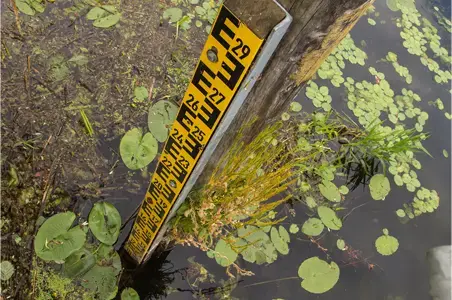From water supply to environmental monitoring: piezoresistive level sensors enable precise and continuous water level measurements – even under extreme conditions. Why they are superior to float gauges.
What cannot be measured cannot be managed
Life giver, danger to life, or just a refreshing drink in summer: Water influences daily life on Earth in many ways. Its significance makes reliable monitoring of this element essential.
From freshwater extraction to drinking water treatment, storage, consumption measurement, and wastewater treatment to hydrometry: Efficient planning requires accurate input variables. Besides traditional methods like float gauges, automated systems such as piezoresistive level sensors are increasingly used.
Water level measurement with piezoresistive sensors
Level sensors are placed at the bottom of the monitored water body and measure the hydrostatic pressure, which is directly proportional to the height of the liquid column. The pressure is calculated according to Pascal’s law:
p(h) = ρ * g * h + p₀
- p(h): Hydrostatic pressure
- ρ: Density of the liquid
- g: Acceleration due to gravity
- h: Height of the liquid column
Since piezoresistive level sensors continuously and automatically record measurement data, they enable monitoring even in hard-to-reach places – without manual readings.
Robust and adaptable – depending on the application area
The choice of material is crucial: For seawater, a titanium housing is recommended; PVDF for galvanic effects. For freshwater, stainless steel usually suffices. An essential feature: proper grounding to protect against lightning strikes.
Versatile – also in tanks
Level sensors work in both open waters and closed tanks. In open waters, relative pressure sensors are used – equipped with a capillary for air pressure equalization. In closed systems where a gas layer presses on the liquid, a differential pressure sensor is employed.
Thanks to high pressure resistance and modular design, measurements are possible at great depths. The only requirement is a sufficiently long pressure sensor cable.
More than just level: includes temperature and conductivity
Modern piezoresistive level sensors measure not only water level but also temperature and conductivity. The latter is an important indicator of water quality. The lower the conductivity, the purer the water.

Conclusion
Piezoresistive level sensors offer a reliable, low-maintenance, and versatile solution for water level measurement – from lakes and rivers to industrial tanks. With integrated additional functions such as temperature or conductivity measurement, they are superior to traditional methods like float gauges in many aspects.
